Chronique:Halo Bulletin 21/11/2012
21 novembre
Original
<toggledisplay hidetext=]Masquer[>

Get Stuffed
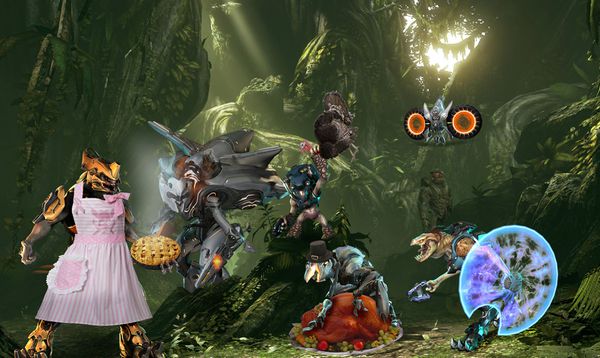
Earlier this afternoon, the streets of Kirkland reached a near-chaotic state as people rushed to vacate their jobs, classes and all semblances of responsibility to begin preparing for their upcoming four-day, food-filled festivities. Now, though, as the sun sets and a layer of darkness seeps over the horizon, I'm left with two things: The burden of unfinished work and the heavy sound of silence broken only by the rhythmic sounds of my lightning fast and deadly accurate transcribing. Yes, I type better than I play Halo. Don't judge.
While I'm bemoaning the fact that I'm still at work, there are other people here in the studio working the night away, too, scheduled to be here tonight, tomorrow and all through the weekend, tasked with the responsibility of fine-tuning, tweaking and optimizing the multitude of experiences that take place both inside and outside the game. Oddly enough, though, the aforementioned individuals don't complain nearly as much as I do, but does anybody, really? (Don't answer that.)
Before I walk out the door and begin my overeating-induced holiday stupor of a weekend, I do believe I owe you a Bulletin. This week we'll be talking about next week's Matchmaking update (yes, you're getting one!), Spartan Ops (now with a developer interview!), Halo 4 concept art (you can haz pretties!), and an amazing batch of images you made in honor of the impending holiday (some of you are hilarious; the rest of you are banned).
Let's get started, shall we?

Next Week's Matchmaking Playlist Update
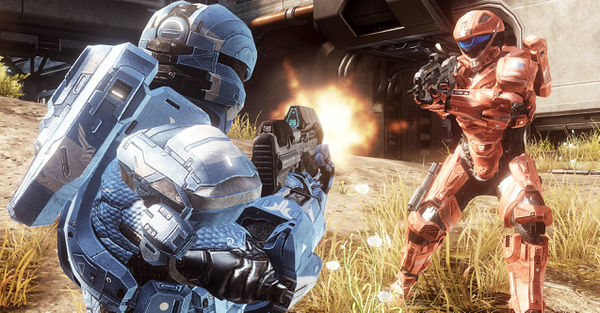
Typically, when you put down a mouthwateringly large turkey on a table surrounded by a ravenous, poultry-craving crowd, the situation turns from jovial to bloodthirsty as people fight over legs, wings, and every last morsel of juicy, delicious meat. You could say it's a battle royale of sorts, which would not be unlike the playlist that is slated to be featured next week. Before we talk specifics, though, let's chat about the update that went live a few days ago.
On Monday, Team Snipers was added to Matchmaking, along with five brand new Spartan Ops missions. Also included in that update were the following:
- Fixed exploit locations on Complex
- Fixed exploit locations on Haven
- Fixed exploit locations on Ragnarok
- Increased daily XP cap
- Reduced weighting for Ragnarok in BTB/KotH/CTF
- Reduced weighting for Haven in Infinity Slayer and SWAT
Please note that the map fixes only affect playlists and not on-disc custom game map variants. We'll continue pushing out Matchmaking fixes for exploits and glitches on Mondays, and we appreciate those of you reporting those issues.
SWAT, Halo 4's very first rotational playlist, continues to perform well so it is sticking around for another week. Team Snipers, however, come the next Matchmaking update, will be swapped out for FFA Throwback. Those of you that were waiting for Monday's update at 2 a.m. PST have already gotten a small taste of this hopper. Those of you that weren't there for the purposeful sneak peek (and by purposeful, I of course mean accidental, OOPS) can get properly initiated with the below information.
FFA Throwback offers two free-for-all experiences in one playlist - Oddball and King of the Hill. If you've been dominating these modes with teammates, see how the game changes when it's every Spartan for themselves.
Below are the maps that will appear in the FFA Throwback playlist.
- Haven
- Adrift
- Complex
- Solace
- Abandon
If you are unfamiliar with Oddball and King of the Hill, here are some tips and tricks to give you a leg up on your competition.
Tips - Oddball
- While holding the ball, if your closest rival or the game leader is close to killing you, try throwing the Oddball away from them to deny them points.
- The Oddball is an instant kill with a melee attack. This is a huge help up-close.
- While holding the Oddball, remember that others can see your location.
- Grenades and weapons with high impulse will push the Oddball away. Use this to prevent an enemy from picking up the ball.
Tips - King of the Hill
- The points fanfare now counts up above your reticle. Keep an eye on exactly how many points you're earning while in the hill.
- Timing when you go into the hill is a big game changer. It's often best to clear out enemies before rushing in.
- Targeting your competition is huge. Take down your closest rivals vying for each valuable point in the hill.
- When a hill reaches 5 points or less, the next hill will be highlighted on your HUD as "INCOMING". Keep an eye on this, and plan your moves in advance.
- On maps with vehicles, use them to help dominate a hill (and earn special vehicle hill medals while you do it!).
Here is a preview of the planned settings for FFA Throwback.
| Mode | FFA Throwback |
| Teams | 8-player FFA |
| Modes | Oddball, King of the Hill |
| Score to Win - Oddball | 100 |
| Score to Win - KotH | 50 |
| Time Limit | 12 minutes |
We hope you continue to enjoy SWAT (Frankie wanted me to tell you that he's continuing to enjoy shooting your face), and we hope you love FFA Throwback when it launches on 11.26. We're going to guess you'll give us your feedback either way in the Matchmaking section of our forums. 'Cause you're kind of sort of good like that.

Spartan Ops: A Developer Interview
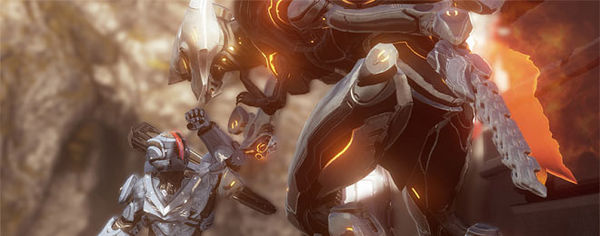
Spartan Ops is our brand new cooperative experience for Halo 4. As caretakers of the lore that comprises the Halo Universe, we're thrilled to have the opportunity to further the story while providing fresh, episode content. Five new missions along with a special computer generated video have been released every week since launch, so I thought it would be fun to dive a bit deeper into this particular game mode.
The Spartan Ops team is hard at work creating new playspaces and missions that you'll soon be exploring, but I managed to talk three of them, Lead Designer Chris Haluke, Senior Designer Greg Murphy, and Mission Designer David Ellis, into chatting with me about their unique line of work. Yes, they're the ones who put large amounts of enemies on the map and craft everything from how and when you interact with them to what weapons and vehicles are available for you to do just that. Not a bad gig, eh?
So, let's start off with a super easy question. What is Spartan Ops?
Chris: Uhhh…Spartan Ops is awesome! With that being said, Spartan Ops is Halo 4's new episodic co-op adventure. We see this as our opportunity to truly innovate within Halo 4's Multiplayer by pushing the boundaries of episodic content.
David: I can't really add much more to what Chris said, but Spartan Ops continues the story of the Halo universe, six months after the events of Halo 4's main Campaign. It's an opportunity to bridge the gap from Halo 4 to future endeavors while also providing a unique set of missions and enemy encounters each week.
As we all know, things tend to change over the course of development. What was the original concept for Spartan Ops?
Greg: It originally was a Firefight-type mode, where it wasn't always about killing all the enemies. Some missions would be get an item (like a bomb) to the bomb spot, kill the leader, capture the item, etc. But it was more arcadey and meant to be replayable. Each map would have the same four or five types of missions. When you played them, it would randomly pick four missions on four different maps, and your party would play through them. We got back to this concept, then onto just concentrating on the five missions a week, then making the missions story driven.
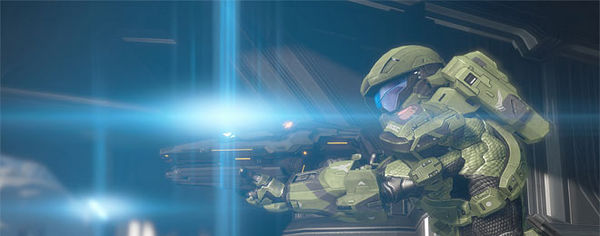
How did that original concept change over development?
Chris: Fairly dramatically, I would say. One of the main changes or evolutions with Spartan Ops was the importance of narrative and tying all of Halo's Multiplayer together with a story that matters. Narrative is an integral part of Spartan Ops, and this truly began to come together at a critical point in production when all the pieces began to fall into place. Working so closely with our narrative team has been an incredible experience, as we all get to feed into the ideas and storylines that ultimately shape Spartan Ops.
Greg: The best way that it changed was going from more arcade-like "random" missions where you would accomplish the same goals, just on different maps in a very generic way, to something story-based, with each mission featuring a unique story, VO, goals, etc.
So you touched on the role that Spartan Ops plays in relation to Multiplayer, but what makes Spartan Ops different from Campaign?
Chris: One of the main differences is the fact that all our missions are designed primarily for four player co-op. We have the luxury of the entire Halo sandbox at our fingertips, and our goal has always been to take advantage of this and create experiences that have never been attempted in Halo Campaigns before. This is truly our opportunity to throw things into the mix that in the past players have only dreamt of. On top of that, we also have a completely new story to tell. Of course the Master Chief is the star of Halo, but Spartan Ops allows us to introduce new characters and build for the future.
David: I think one of the unique aspects of Spartan Ops is the constraints we work through, as designers, to bring these missions to life. Because we're limited to a single map or location for each mission, we have to rely more heavily on Halo's combat and AI sandbox. As Chris said, we are also allowed a little more creativity in how we set our encounters up because of these same limitations. We also have the unique advantage of working closely with our narrative team, who let us be as creative as possible with our missions and then wrap the story around our designs.
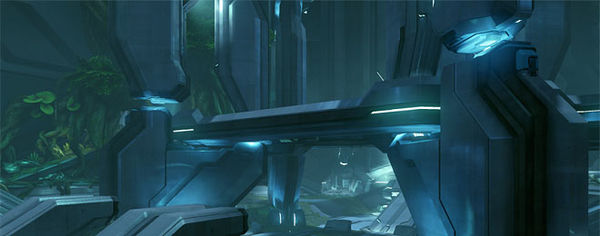
Speaking of which, can you give us a synopsis of what has happened thus far in Spartan Ops story-wise?
David: The first two episodes slowly introduce players to the characters and concepts of Spartan Ops. You're introduced to Fireteam Majestic (the Spartan Squad in the CG series) and re-introduced to returning characters from Campaign like Thomas Lasky and Sarah Palmer. The introductory missions in the first few episodes serve a similar role of educating the player on the similarities and differences between Spartan Ops and other PvE (player versus enemy) modes. Bringing Dr. Halsey into both the CG series and the missions themselves this week brings a whole other level of gravitas into the story we're telling. In a lot of ways, we're still setting the table for this season, but there are some major revelations and actions coming throughout the season.
You mentioned both the CG series and also missions. What exactly is the weekly cadence for Spartan Ops?
Chris: Each week players will get a new episode of the CG series that tells of life on the Infinity and beyond. With that CG episode, players will also get five new playable missions each week. So overall, players will get ten episodes of the CG series and 50 missions overall. The beauty of Spartan Ops is that all of the playable missions directly tie into narrative threads that are being told in the CG series and vice-versa. Players will feel as if they're active participants as not only do they get to watch the CG series but they also get see how their actions help drive the overall story forward.
David: This is probably one of the things that has changed the most since we started production on this season of Spartan Ops. This whole concept of "episodic" gaming is still a relatively untouched element in this industry. A select few companies have taken advantage of this medium (most notably Telltale games) but there is no wise guru of episodic gaming. So, in a lot of ways, we were making it up as we went along in the early days of planning. We had to figure out if the missions should tie directly into the CG series and if so, how? We also introduced the concept of having overarching story arcs that carry over between chapters within the episodes themselves. Episode 3 is probably the first one where we worked across designers and narrative to really try and tie all these disparate pieces together. I'm really looking forward to seeing the reaction to the players as our storytelling and design process evolve over this season.
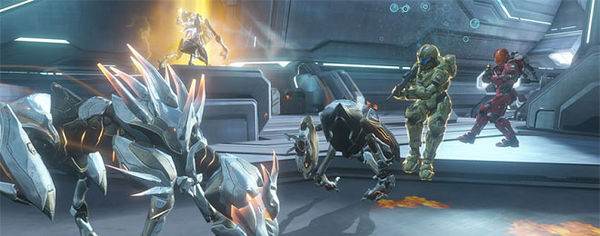
50 missions is a lot! Where do the playspaces for all these missions come from? Are they all original, or will players recognize them from other game modes?
Chris: The play spaces and environments used within Spartan Ops originate from several different backgrounds. We wanted to offer the player new spaces along with spaces that they may be familiar with. Simply having players ask the question, "Hey, is this the same area that the Chief was in?" was a way that we could tie in that familiarity with Campaign and War Games alike. One of the keys to our playspaces was to ensure they could support multiple missions and be exciting no matter how we presented them. Allowing players the freedom to engage how they want was certainly a key to both the playspaces and mission setups themselves.
David: Let's be honest, in a perfect world with unlimited hours and resources, we want to have as many unique playspaces as possible. But, within the scope of this particular part of the project, we knew early on that didn't make sense from a logistical or production standpoint. So we worked hard to provide locations that would allow players to have unique experiences each time they come back to a familiar locale. It really is surprising how unique a space can feel by just adjusting spawn locations and enemies encounters in a space you've played on previously. One of my personal favorite parts was the opportunity to introduce Two Giants (our version of Ragnarok) as a playable space within Spartan Ops. Back in my Halo 3 days, I had always wanted to know what it would be like to fight against Covenant enemies in this space. Spartan Ops allowed me to realize this vision. As mission designers, this constraint means we have to be really smart about how we roll out the missions that take place on these levels. In particular, for Two Giants, I purposefully constrain the item and spaces that the player can interact with the first time you set foot in this canyon. As we transition from one mission to another in this space, we open up one of the bases and even bring in new sandbox elements from the outside.
I'm not a designer, so I have no idea how you go about making a mission. Can you talk us through that process?
Chris: We basically have a big wheel that we spin and whatever it lands on, we make! Okay, so maybe that's not the case. In all honesty, we start by creating compelling spaces that we know players will enjoy coming back to. From there, the design team has the freedom to create a series of encounters that fit with both the environment and narrative beats we need to hit. Rapid prototyping, creation, and playtesting are the keys for the Spartan Ops process. We always have to move forward while constantly iterating. This is a philosophy that the team has firmly embraced.
David: "Always be iterating" is a mantra that I still wake up chanting from time to time. As Chris said, the first step is figuring out the order each location shows up in each episode. Once we have the map cadence laid out, we'll come up with mission objectives and work with the narrative team to figure out the themes and story beats for each mission. We will have the bare bones of a mission up and running in less than a week. This is by no means final and usually includes work-in-progress story beats with hilariously bad dialogue written by the designers. We'll play through each iteration together as a team, providing constant feedback to each other along the way. Because of our production schedule, we do not have the luxury of months of iteration time. We have to prove whether a concept works, is fun and makes sense for the mission we're working on quickly. This can lead to some tough decisions as occasionally we have to cut pet ideas we don't have enough time to do justice. The bright side to that is we're always working on new missions, so we often have opportunities to revisit these concepts.
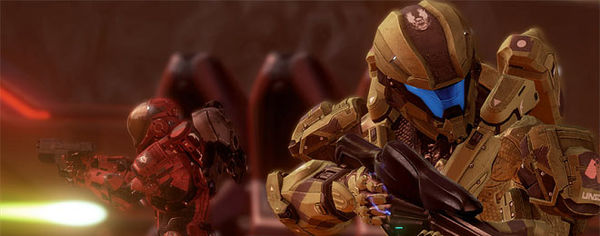
What is the best part about being a Spartan Ops Designer?
Chris: By far, it's seeing the incredible creativity and excitement throughout the Spartan Ops Team. This is evident in the art, narrative and design teams. The designers are constantly figuring out compelling new ways to push the Halo sandbox as well as each other. There's definitely a healthy competition amongst the team to create the coolest, most memorable missions possible. In saying that, one "nameless designer" even has a glowing shout-out from our very own Palmer voice actor, Jennifer Hale. But I'll leave it at that.
David: I would say the Spartan Ops team is probably one of the tighter nit in the studio. Because of Spartan Ops very nature, we have to be more collaborative when working on our missions. We're always bouncing ideas off of one another and I think (as Chris mentioned) the competition helps to further this creative process and to always drives us to make each mission better than our last.
I'm intrigued by the Jennifer Hale shout-out. Before I start trying to solve that mystery, can you tell us the most challenging part of creating Spartan Ops missions?
Chris: I can think of several challenging aspects of creating Spartan Ops missions. One of the front runners is the fact that we were trying to create something that had never been done before in an extremely aggressive schedule. Creating this sheer amount of content can be challenging at the best of times, but to have never done it before added to complexity of the challenge. I will say that this rapid creation was also a key contributing factor to our team being so incredibly focused throughout production. So by providing the team with an obstacle, in reality, it allowed them to develop trust and build chemistry for the future.
David: I think Chris's point is right on the money. We really didn't know what we were doing when we started putting this episodic experience together so we had to make a lot of mistakes early on before we could begin production in earnest. The other part that I personally had the most trouble with was keeping track of all the various stories and plot threads we are trying to tell. I often comment that Spartan Ops is bit like a matryoshka (or Russian nesting) doll. We have the story we're telling in the CG series, which itself has several narrative threads, then one layer down, we have the overarching story we're telling through the gameplay portion of each episode and finally, we have the stories we're telling in each individual mission. All of these stories need to be aligned and all moving in the same direction for players to truly experience what Spartan Ops is all about.
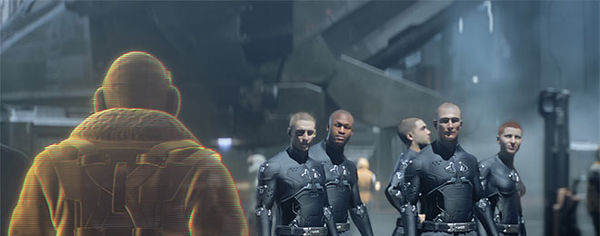
So that covers Spartan Ops thus far! Let's look forward, though. What do the people reading this have to look forward to in the future for Spartan Ops?
Chris: Well, that would be giving away all of our secrets wouldn't it? Okay, okay, so we do have a few tricks up our sleeves for the future. Do players enjoy new and never before seen playspaces and environments? Check. We have them! Do players enjoy cliffhangers? Check. We have more! Do players enjoy that phenomenally deep Halo fiction and lore? Check. Our narrative and design teams will certainly keep you wanting more!
David: I'm really looking forward to seeing how players react to the all-new environments and locales that we have coming later in the season. One sequence of missions in particular brings a grin to my face every time I think about how cool that will be for players when they experience it for the first time. I think people will really be surprised by the scope of the story we're telling with this season of Spartan Ops. As these things often do, we're starting relatively small, but if you've been keeping up with the story, trust me, things are just getting started.
And with the mention that things are just getting started, that brings us to the end of this particular developer interview. Thank you to Chris, Greg, and David for answering my questions, and stay on deck, please, because I will undoubtedly have more in the future. Until then, enjoy this week's missions!
Oh, and don't forget: you can check out all your Spartan Ops stats (best time per mission, medals, game history per chapter, and more) by signing into Halo Waypoint and clicking the Halo 4 logo located on the top right corner of the page.

=Art of Halo 4 Dossier
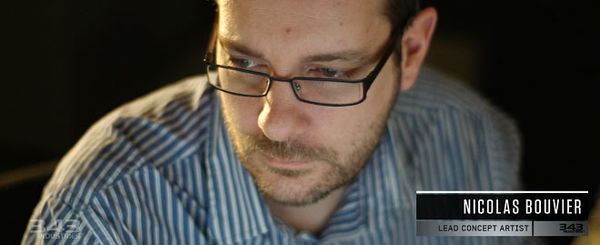
We have numerous talented artists within the studio, one of them being Nicolas Bouvier. Also known as Sparth, Nicolas has been an active artistic director and concept designer in the gaming industry since 1996. One of his greatest passions is contemporary and futuristic architecture, of which he applies principles in his own art and photography. He has contributed to the development of several released games since 1997, including Alone in the Dark 4 (2001), Cold Fear (2005), Prince of Persia - Warrior Within (2004), Assassin's Creed (2007) and Rage (2011). He joined 343 Industries in 2009, and below is a small snapshot of the work he did for Halo 4. Accompanying each piece of concept art is a description, penned by Sparth himself.
Complex multiplayer map interior: This is one of the interiors we designed for the multiplayer level named "Complex", a map Derrick Hammond was taking care of with his team. "Complex" is mostly an exterior map, but you still have several areas like in the main building where you will find moodier atmospheres with less direct natural light. This concept was done for the main room where the UNSC has been studying a large Forerunner monolith, very reminiscent of the Atrium monolith from the campaign "Composer" mission, but in smaller proportions. The image clearly shows a lot of opening, suggesting multiple levels, so we had to definitely simplify a lot of it once it was modeled. The final 3D result is having more vertical walls without the opening you see in the concepts, but the atmosphere and general detailing remained the same.
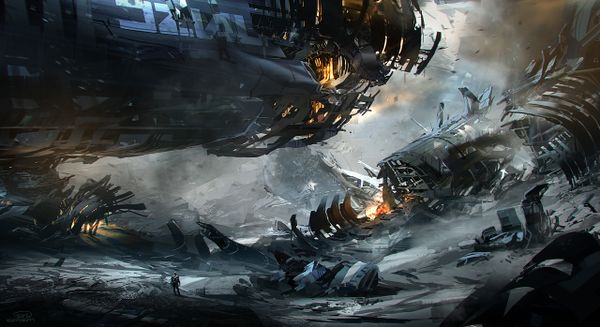
Requiem crater crash site: We actually did several versions of the crash site. Happening in the "Requiem" mission, it takes place on the Requiem planet, when the Forward unto Dawn crashes on its surface. We especially wanted to insist on the overhanging piece of structure you see in the concept, and this in order to emphasize the epic and impressive aspect of the level, as well as reinforce the feeling of danger [and] of having something massive above the Master Chief's head, something ready to fall and crash on the ground.
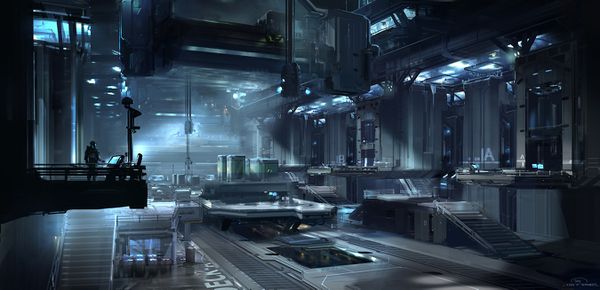
Infinity interior: One of the first Infinity spaceship interiors, probably the very first one we finished. We knew the ship was going to be having gigantic proportions, so it gave us quite some freedom to work on large interiors. This concept was initially started by Jihoon Kim, [from whom I] managed to obtain a good base to work. I then brought the image to another level of detail by spending quite some time describing the aesthetics and architecture, which is mostly what I would call "military tech", a term describing best the UNSC visuals when it comes to design shapes and rhythms.
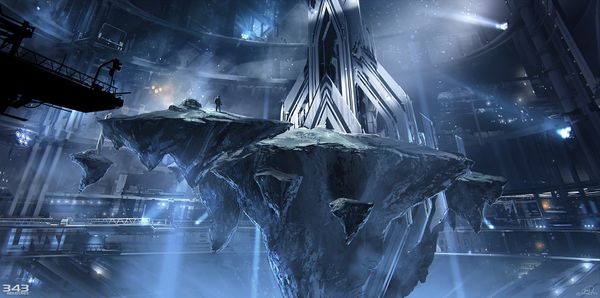
Composer: A concept for the atrium area within the space station. The central monolith went through several iterations before finding the right one. On this concept, it looked a bit more cathedralesque, but not "Forerunner" enough. The initial idea that remained was that this piece of architecture was so deeply rooted into the planet's ground that they had to remove a large chunk of the planet's surface to remove it.
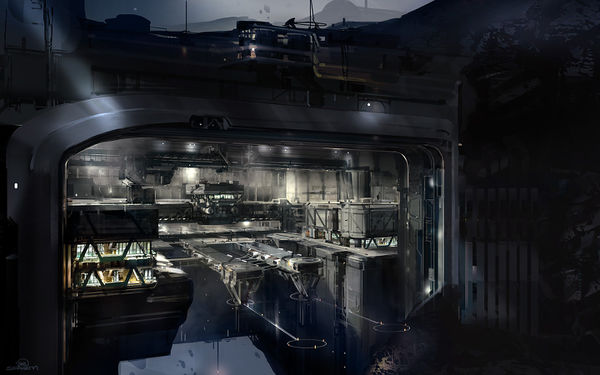
Composer: The docking area of the space station was initially called the "horseshoe" by the 3D team because of its "U" shape from above. It consists of a super extended space opening with a horizontal crane on top. The piece was supposed to be mostly inspirational at first, meaning that a lot of the gameplay areas weren't supposed to show but Adam Peterson and Paul Ehreth managed to magically integrate a lot of the original concept in the final layout. As a result, the 2D concept and 3D final product are sometimes very similar.
We hope you enjoyed this teeny tiny peek behind the curtain of the development of Halo 4. Many thanks to Sparth, both for sharing his work and providing insight into his concepts. Stay tuned for more art spotlights in the future!

Fun with Photoshop: Thanksgiving Edition!
Yesterday, on our forums, I presented you with a challenge: Create a Halo-themed Thanksgiving or fall picture using your favorite image altering software. Below are just a few of the images you created. The rest are not suitable for public consumption. You know who you are…
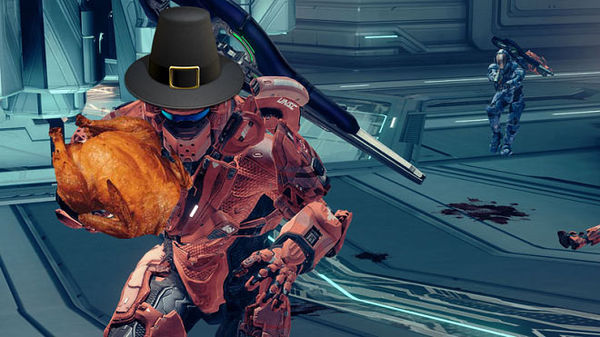
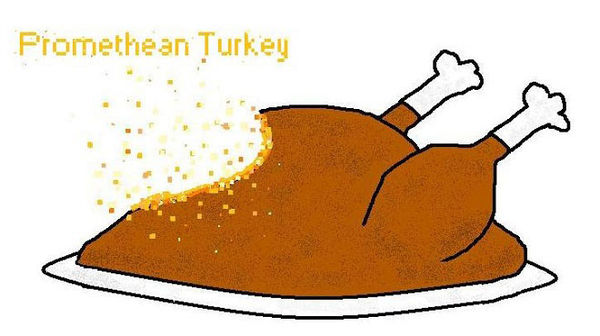
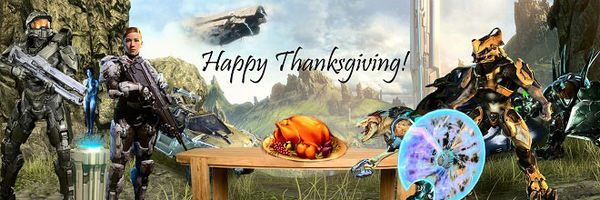
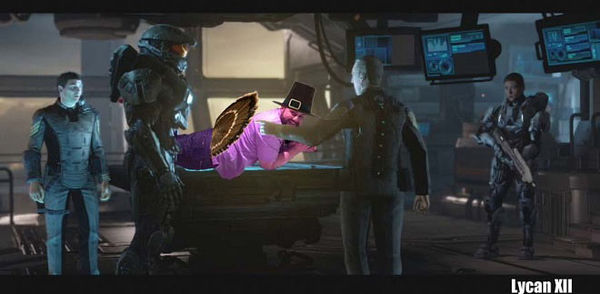
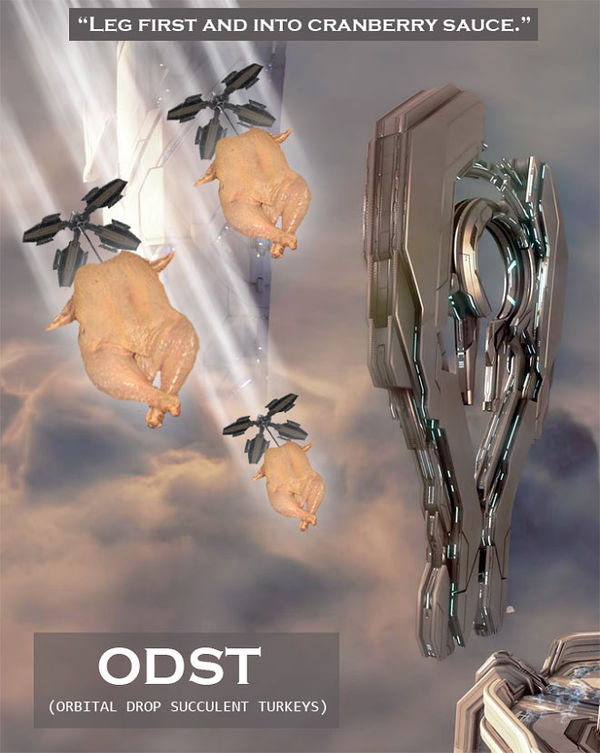
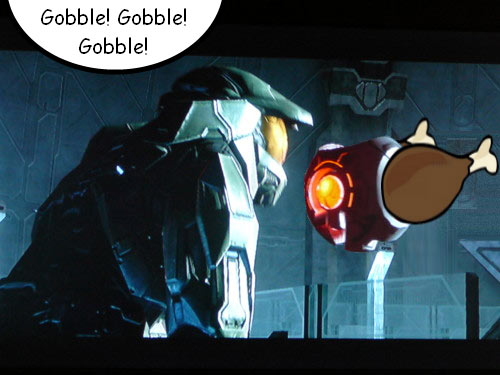
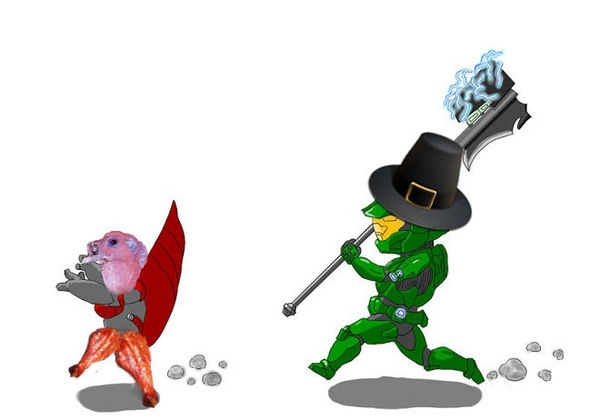
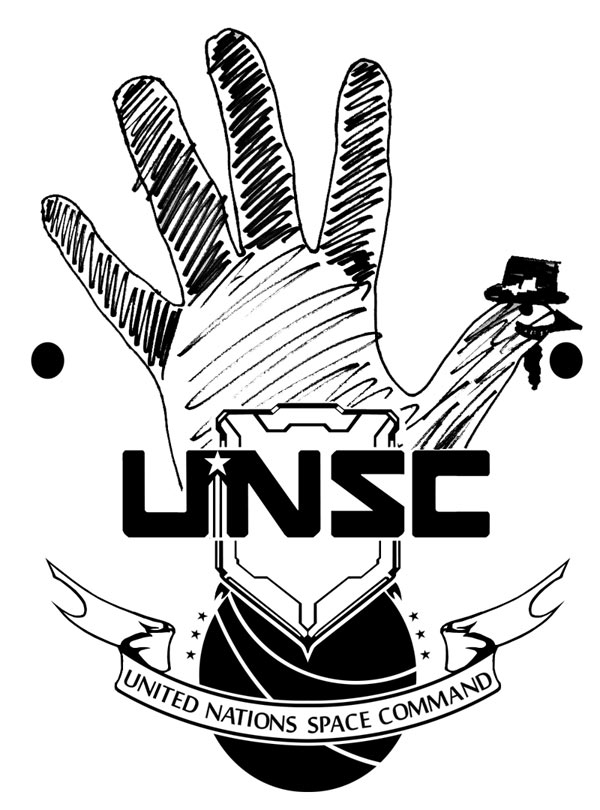
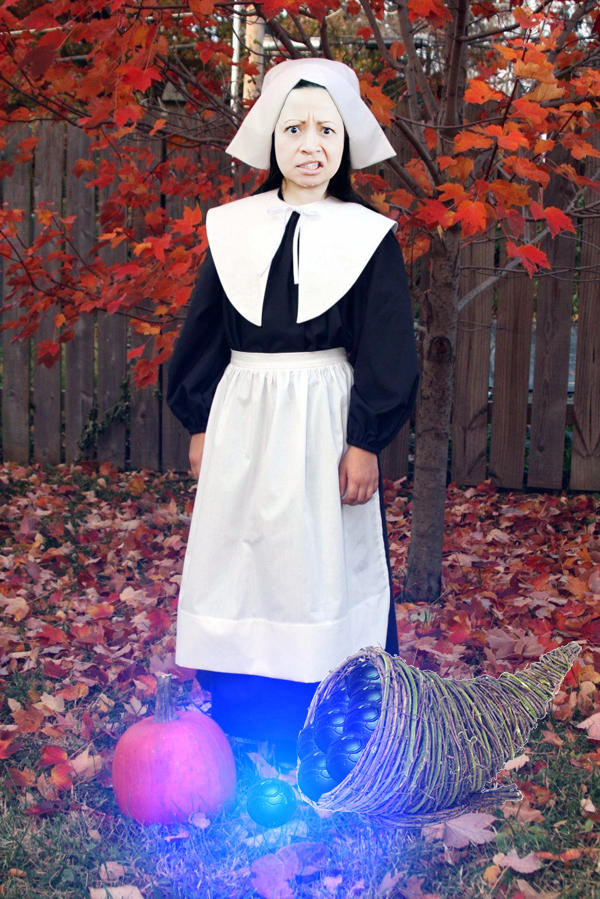
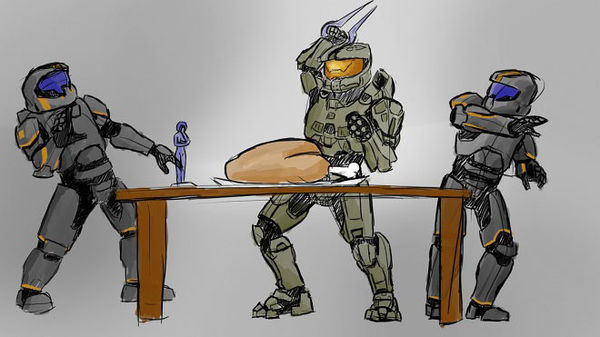
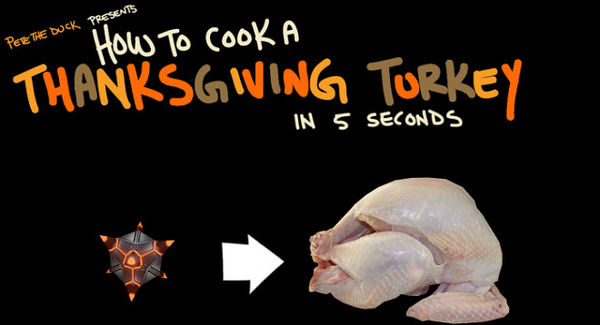
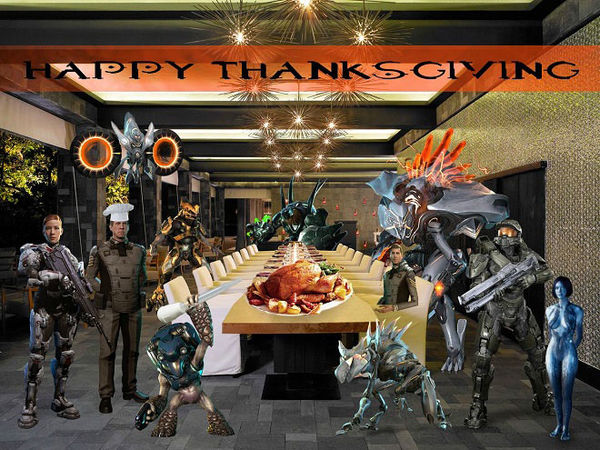
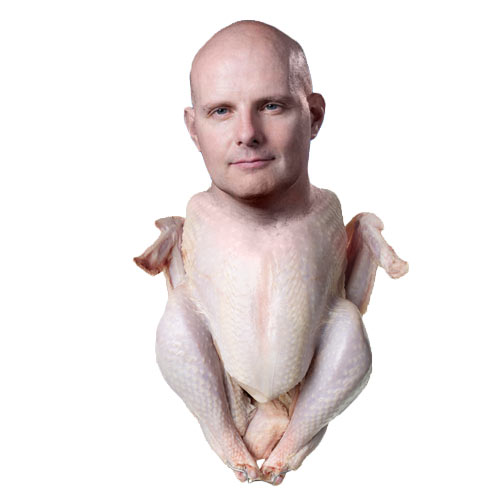
To quote myself from a few hours ago, the Frankie turkey is officially in, which may mean I'm officially out. I guess we'll know one way or another next week. Until then…
<3, bs angel
P.S. Discuss.
P.P.S. Happy Thanksgiving, to those celebrating. :)
</toggledisplay>
Traduction
Une traduction partielle a été réalisée par Elros sur Halo Creation.